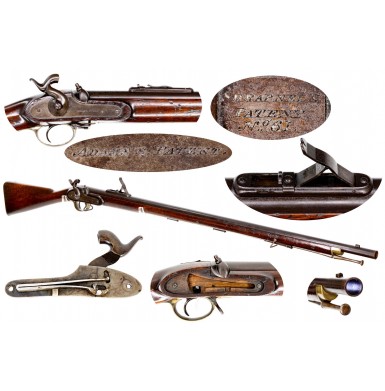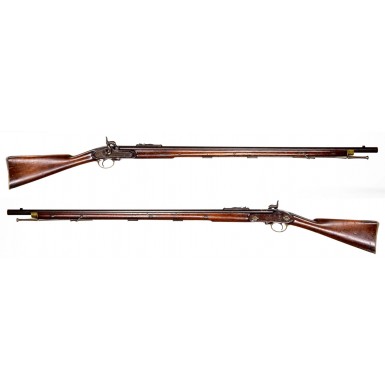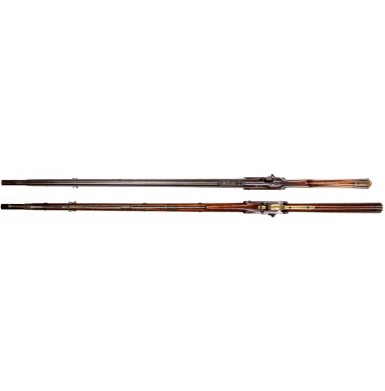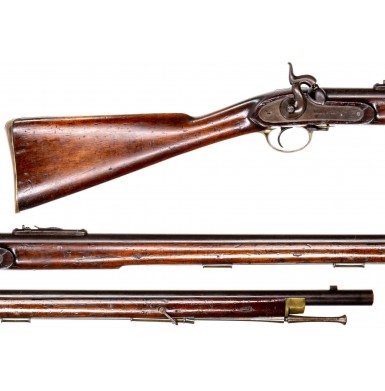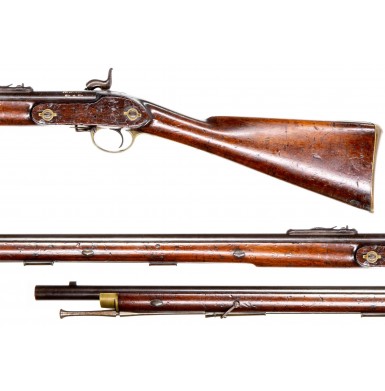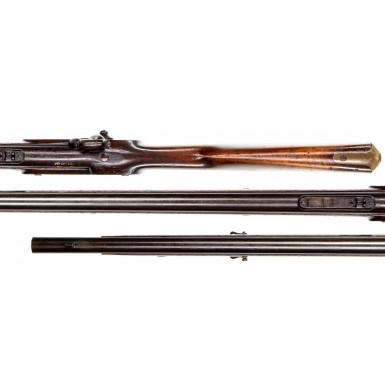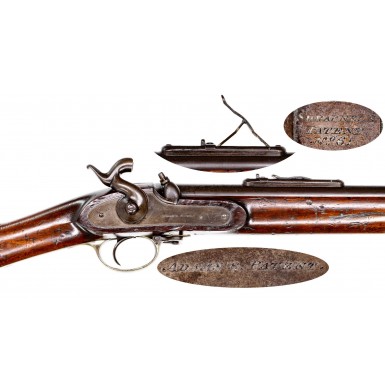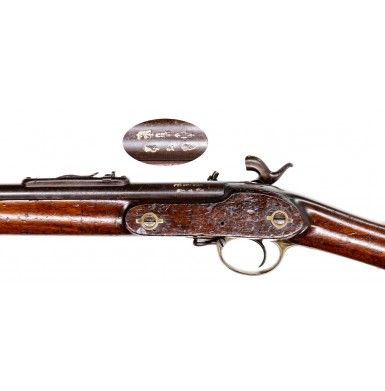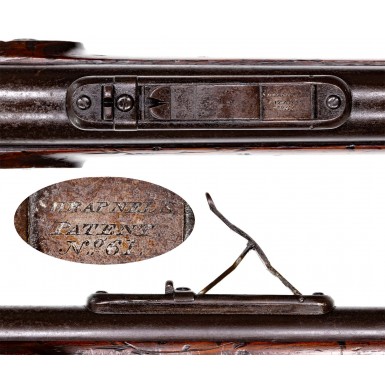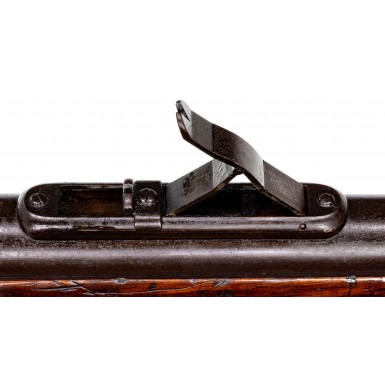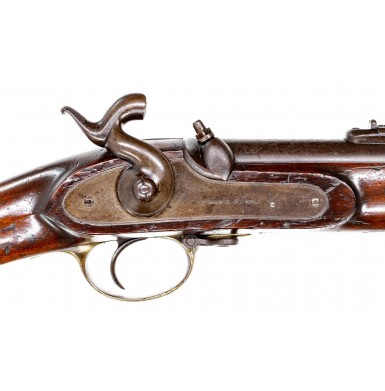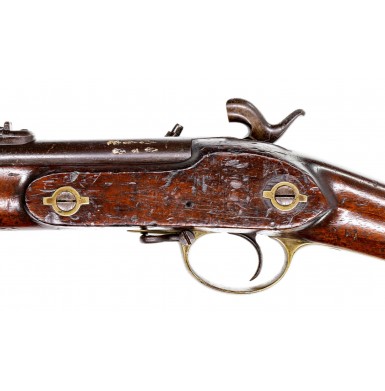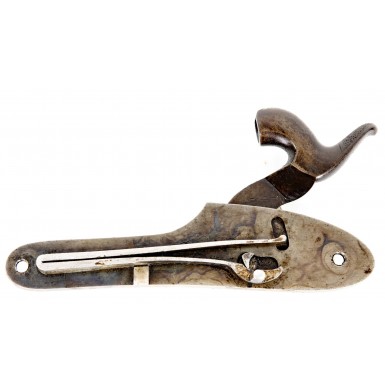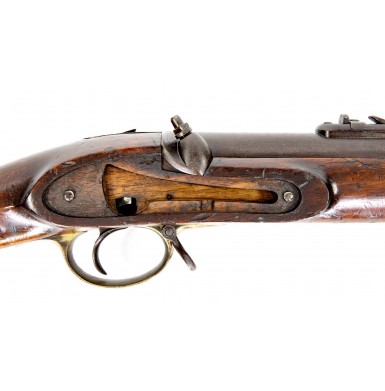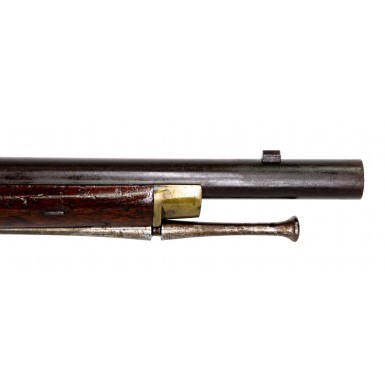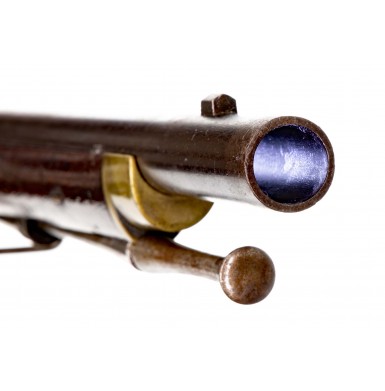Extremely Rare Adams' Patent British Military Musket with Shrapnel Patent Rear Sight
- Product Code: FLA-3770-SOLD
- Availability: Out Of Stock
-
$1.00
The period from about 1850 to 1855 was quite turbulent within the British Board of Ordnance as a new direction was being taken in the design of small arms for the British Army. In that short period of time the average British line infantry solider went from carrying a nominally .75 caliber smoothbore musket to a .577 caliber rifle musket, drastically changing the capabilities of the British infantry that had been essentially unchanged since the 1750s.
In 1840, George Lovell had been made Inspector of Small Arms and though he had been helping to design and develop small arms for some two decades prior to that appointment, it was the 1840 appointment that finally placed him in the position to have one of his primary development goals realized, the adoption of a rifled arm for general issue to all members of the British military. Lovell had been fixated since the 1830s on the development of a superior percussion ignition musket, which culminated in his Pattern 1838 Musket. This was a back action lock design that was significantly superior in quality and efficiency to the current production front action locks. While this pattern was initially adopted, the economic need to use up existing stocks of older flintlock pattern parts, as well as to potentially alter earlier flintlock muskets, resulted in Lovell’s Pattern 1838 design being set aside. Instead the new Pattern 1839 Musket was adopted, essentially a New Land Pattern Musket with a percussion, rather than flint ignition system. This meant the Pattern 1839 was nearly identical to earlier flint muskets, with only the lock and breech being significantly different. The fire that destroyed much of the Tower of London armories and workshops on October 30, 1841 destroyed more than 280,000 small arms in inventory. This freed Lovell to start a more radical move away from the traditional flintlock pattern that had been forced upon the Ordnance Department from the restrictions of economy and allowed the freedom to start developing better arms.
The next pattern to be adopted was the Pattern 1842 Musket, a refined and better designed variant of the Pattern 1839. Like the Brown Bess muskets dating back to the mid-18th century, the guns were still nominally .75 caliber and smoothbore. Lovell, however, was still looking for a way to reequip the British military with rifled arms, rather than smoothbores. This required finding a way to load the arms with sub-caliber ammunition that could be loaded as quickly as a smoothbore, but that was capable of expanding when loaded or fired to effectively use the rifling. Numerous solutions were experimented with during the 1840s, primarily using the various French systems like the Thouvenin and Delvigne breeches. However, it was Minié system of sub-caliber, expanding base ammunition that finally solved the most pressing problem regarding the issue of rifled arms to all soldiers. Lovell began working overtime, in conjunction with the British military’s Committee on Small Arms. The first result was a smaller caliber, rifled arm with a .702” bore and long range rear sight, designated the Pattern 1851 Minié Rifle. Again, the overall design looked little different than earlier flintlock and percussion muskets with pinned and later wedge retained barrels, no barrel bands and ramrod pipes, in a style little changed since the 1750s. Almost immediately a more advanced, smaller caliber rifled long arm was under development.
1852 saw a huge number of designs and concepts evaluated and eventually tested by the Committee on Small Arms. The details of this study was later published as the Report of Experiments with Small Arms Carried on at the Royal Manufactory, Enfield, 1852. A large number of designs and concepts were submitted for initial evaluation but in the end only five manufacturers were selected for a final intensive testing of their designs. The various makers understood that beyond contracts to produce arms for the British government one of the most lucrative things a gunmaker could do was to develop and patent or a design that would be adopted as a feature in a British military arm. Adoption of such a patented system would result in either a large lump sum payment to the designer by the government or the repeated payment of royalties based upon the numbers produced. During the period when the Pattern 1839 and Pattern 1842 muskets were being developed, the automatic priming system of Baron Heurteloup was experimented with and similarly during this period an underhammer design by Wilkinson was evaluated as well. By the 1850s the general belief among the gun makers was that the patented features most likely to be adopted by the Committee on Small Arms were either a lock design, or rear sight design or a system of rifling. As a result, large numbers of innovative and patent protected innovations flooded the Small Arms Committee and Lovell as they proceeded to try to develop the next step beyond the Pattern 1851 Minié Rifle, which would eventually result in the Pattern 1853 Enfield.
According to research published in Adams’ Revolvers by W.H.J. Chamberlain & A.W.F. Taylerson Robert Adams applied for a British patent on February 24, 1851 that “covered an improved construction of rifle barrels; improved gun or pistol locks and various safety systems” the patent went on to cover a concept for multiple revolving chambers that would align with a single barrel, but it is the lock patent, covered by British Patent #13527/1851 that is represented in part by the musket offered here. Chamberlain & Taylerson go on to note that “With benefit of hindsight, we can now see his revolver as the most valuable item covered by Adams’ patent but, in fact, the truly relevant areas of invention for his own day lay, seemingly, in those described improvements to long arms. The British Board of Ordnance had concluded a series of rifle-trials during 1850 and, although no formal decision had been reached, the gun-trade was well aware than a muzzle-loading service-rifle would soon be adopted for general issue (and not merely for special units) which, for a peace-time army of 120,000 men, promised excellent business for anyone who could interest the Board, either in a particular arm, or even a lock-mechanism for or rifling-system for one.” During the 1851 Crystal Palace Exhibition in London, Deane, Adams & Deane displayed no revolvers based upon Robert Adams Patent #13527/1851 but did display “patent gun locks” among other items. In fact, a sporting version of lock used in this musket is depicted in the 1851 Exhibition Catalog, which is reproduced by Chamberlain & Taylerson on page 29 of Adams’ Revolvers.
Offered here is an example of what was almost certainly Robert Adams’ attempt to gain acceptance for some of his musket design concepts from George Lovell and the Small Arms Committee. The gun for all practical purposes appears to be a Pattern 1851 Minié Rifle with a few specific differences and enhancements. The lock is a military musket sized version of Adams’ patent #13527/1851 lock. The lock is an incredibly interesting and simplified system and is marked in a single engraved line, using less than correct grammar: ADAMS’S PATENT. It is worth noting that when Adams started to produce his famous revolvers, the extra “S” was dropped from the patent markings. The lock is screwless and the lower end of the mainspring terminates in the teeth normally associated with a tumbler. The sear is a projection from the lower body of the hammer that engages the “tumbler”. The tumbler has a projection that functions as a trigger bar, which is released by the trigger bearing on it from above, pushing the “tumbler” down and releasing the hammer, rather the more conventional system of the trigger pushing up on the sear bar. The system is amazingly simple and elegant and functions very smoothly with a much lighter and crisper trigger pull than normally found on a conventional military musket. As there is no conventional tumbler, the hammer has a male threaded post and spanner nut that secures it to the lock. The use of a spanner or “bun nut” to secure the hammer to a male threaded post is most often found on arms intended for use by British Colonial Troops in India, where the dismantling of arms was even more discouraged than within the British regular arm. The system is actually quite intelligent makes sense for an army that at the time was composed primarily of the lower echelons of English society who were not to be encouraged to dismantle their arms. The musket also includes a unique patent rear sight, or “back sight” as the British referred to it, that is engraved in three script lines:
SHRAPNEL'S
PATENT
No 61.
The sight is fully adjustable for elevation and is of an intriguing design. The sight is a folding leaf that slides along a base with a hinged support that allows smooth and even adjustment through the full length of travel along its base. The base is 4” in length with a fixed notch at the rear, providing a quick acquisition rear sight that is likely sighted for between 50 and 100 yards. Pulling up on the sliding elevating leaf allows it to reach a maximum height of roughly 2” above the base, resulting in a nearly vertical alignment angle between the rear sight and front sight. The system is reminiscent of the triangularly shaped folding leaf used on the Bavarian Model 1842 Rifled Musket. In both cases the ballistics of the ammunition and distances that sights suggest they are trying to achieve, results a firing angle more akin to the indirect fire of a mortar rather than a rifle! Lieutenant General Henry Shrapnel (1761-1842) is probably best remembered today as the inventor of “spherical case” artillery ammunition, a hollow projectile filled with explosives that was designed to detonate via a fuse system over the heads of enemy troops. Today, his name has become synonymous with the cause of most wounds due to artillery fragments; “shrapnel”. His inventions also included a tangent sight for artillery, which this design is likely based upon. General Shrapnel’s son, Captain Henry Needham Scrope Shrapnel (1812-1896) served as an advisor to the Committee on Small Arms during the 1852 period when the specifications for what would become the Pattern 1853 Enfield Rifle Musket were being developed. During the process of developing the Pattern 1853 a large number of experimental backsights were tested, with no clear winner even after the pattern had essentially be established. The inability of the Committee on Small Arms to make a final decision about the form of the back sight meant that the initial order for the guns included two types of rear sights. As Shrapnel’s’ son was an advisor to the board it is quite likely that he championed the back sight design found on this musket, something he likely developed based upon his father’s artillery tangent sight patent. Interestingly the younger Shrapnel was always in need of funds and although Parliament had granted his father a yearly £1,200 stipend for the invention of the Shrapnel Shell, the stipend was only for his father’s lifetime and was not conferred upon his heirs. As a result, in 1869 Captain Shrapnel unsuccessfully pursued additional funds from Parliament to recognize his father’s achievements, which were not forthcoming. However, in 1852 the adoption of a Shrapnel Patent rear sight might have been seen by the man as a good way for the younger Shrapnel to make some money.
It is also worth noting that in addition to Captain Shrapnel, both Robert Adams and his partner in Deane, Adams & Deane, John Deane also served in the same advisory capacity to the Committee on Small Arms during the development of the Pattern 1853. The inclusion of firearms makers, designers and experts in the process to help advise the Committee on Small Arms had been initiated by the Lord Hardinge (1785-1856), who had recently been appointed Commander-in-Chief of the British Army, succeeding the Duke of Wellington. Hardinge had served under Wellington during the Napoleonic Wars and lost his left arm at the Battle of Ligny, only days before Waterloo. Hardinge later served as in Parliament from 1820-44 and as Governor General of India from 1844-1848, where he also oversaw command of the army during the First Sikh War. Hardinge would also serve as the Commander-in-Chief during the Crimean War.
This Experimental Adams’ Patent Musket offered here remains in VERY GOOD+ to NEAR FINE condition and was almost certainly supplied during the 1852 trials to try to sell the Committee on Small Arms the concepts of the Adams’ Patent Lock and the Shrapnel Patent Back Sight. The gun is essentially produced in the form of the Pattern 1851 Minié Rifle, with the primary differences being the use of the Adams lock, the use of the Shrapnel rear sight, the elimination of the Lovell’s catch for the bayonet and use of a swelled and grooved ramrod design that locks into place on the bottom edge of the nose cap. The musket is nominally .71 caliber, just slightly larger than the standard Pattern 1851 .702” caliber, but is smoothbore. The reduced caliber makes it clear that it is not a Pattern 1842 Musket, but the lack rifling is confusing. It is not clear if the gun was bored smooth after trials, if the gun was submitted as a smoothbore or if the gun was going to be rifled with patent rifling of some sort which was never cut. Interestingly the gun barrel was probably a Pattern 1851 barrel purchased from Ordnance Stores. This belief is based upon the fact that the upper left section of the breech is marked with both British military proof and inspection marks as well as a full set of London commercial proof marks. The bottom of the barrel is marked by long-time Birmingham barrel maker BEASLEY and with a British military {CROWN}/B/5 inspection. The barrel also has the mating mark of four file slashes, / / / / underneath. This same mating mark is found in the barrel channel of the stock, which is equipped with the standard Pattern 1851 pattern ramrod spoon. The barrel measures 39.5” in length and is secured by three keyed wedges, the screw for the upper sling swivel and a single screw through the breech plug tang, in the same fashion as the Pattern 1851. The overall length of the gun is 55.25”. The Pattern 1851 measurements are nominally 39” barrel and 55” overall. The gun is stocked to within 3.5” of the muzzle. Other than the lock, rear sight and ramrod retention system the gun follows the standard Pattern 1851 format. Three brass pipes hold the ramrod in the channel under the stock and a pair of sling swivels are provided, one on the front bow of the triggerguard and one through the stock above the center of the upper pipe. Although the lock is of the Adams’ Patent variety the hammer retains the Pattern 1851 profile with curled spur at the end. The furniture is of the standard Pattern 1851 style, with a brass triggerguard, buttplate, nose cap, square-eared Lovell’s sidenail caps and rammer pipes. Like most Pattern 1851s, the gun was finished with a browned barrel, color casehardened lock and is mounted in an Italian walnut stock.
As noted, the gun remains in VERY GOOD+ to NEAR FINE condition. The browned barrel retains about 20% of its original browning on its exterior which has mixed with a lovely, evenly distributed, oxidized brown patina. The even blending of the original finish with the oxidation, has given the barrel a wonderful, untouched look. The bottom of the barrel, where the stock has protected it, retains about 75% of its original browned finish. The surface of the barrel shows scattered surface oxidation and freckled patches of very light surface roughness. This is most noticeable around the breech, with the balance of the barrel being mostly smooth with only some scattered flecks of minor roughness here and there. The color casehardened lock and hammer have faded to a brownish-gray patina with only traces of mottling visible on the exterior. The interior of the lock retains about 80%+ of its original case coloring, which has faded and dulled with age. The lock functions perfectly on all positions and as noted is lighter and crisper than the typical British musket lock of the period. The bore of the musket is in about VERY FINE condition and remains mostly mirror bright along the majority of its length, with some scattered oxidation and some patches of discoloration. The last two to three inches of the bore, nearest the muzzle, show moderate surface oxidation which could probably be scrubbed and cleaned, resulting in nearly the entire bore being mirror bright. The brass furniture has a medium dull golden patina, with the rammer pipes having the darkest patina, the triggerguard somewhat brighter and the buttplate and nosecap having a mellow golden color. The original Shrapnel’s Patent rear sight remains in place and is fully functional, operating smoothly across the full range of movement. The original “doghouse” style combination front sight and bayonet lug is in place on top of the barrel, near the muzzle as well. What appears to be the original buttonhead ramrod is in place in the ramrod channel. It resembles some of the swelled shank ramrods used on carbines in British service during the early 1800s and has a groove in the center of the swell to engage the bottom lip of the nose cap, thus retaining the rod. The rod is a button head design without a concave face, suggesting that the maybe the gun was never rifled, as concave rod heads are standard for elongated ball ammunition and convex head rods like this were normally used with round ball. The rod appears to be full-length other than the threads at the end, which are broken off. In its current condition the rod measures roughly 38” and was probably about 38.5” when the threads were in place. The stock of the gun remains in about VERY GOOD+ to NEAR FINE condition as well. The stock is solid and full-length and free of any breaks or repairs. The stock shows numerous scattered bumps, dings and mars from handling, storage and use and shows slightly more wear than the balance of the gun. This would not be unexpected as any sample or experimental musket would show more wear and use on the stock than any other part.
Overall, this is an extremely interesting and potentially unique Experimental Adams’ Patent British Musket with a Shrapnel Patent Rear Sight. In more than 20 years of studying and collecting British military and related arms from the mid-19th century I have never seen an Adams’ Patent musket or a Shrapnel sight. I have been trying with no luck to find a copy of the Report of Experiments with Small Arms Carried on at the Royal Manufactory, Enfield, 1852 to try to find out more about how the design may have been received. I do have a period study of British rear sight designs on the way that may shed some more light on the Shrapnel sight, but right now I have presented everything that I know or have conjectured based upon my knowledge and research. The lock design appears to be a significantly better design than the Lovell design, particularly in terms of simplicity and functionality, but it may have been more costly or difficult to produce. It is also likely that the British Board of Ordnance was unwilling to pay the royalties on such a design. For any collector of mid-19th century British arms, particularly one with an interest in sample, pattern and experimental arms, this would be a wonderful addition to your collection. The gun is in very nice condition, is 100% complete, correct and original and is essentially untouched. The gun is certainly worthy of additional research and if I learn anything more about it, I will be updating the description to reflect it.
SOLD
Tags: Extremely, Rare, Adams, Patent, British, Military, Musket, with, Shrapnel, Patent, Rear, Sight

